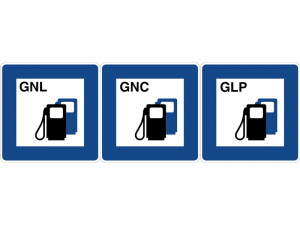The revolution of fuels to eliminate carbon emissions is changing our society. Road freight transport has not been left on the sidelines and has added new acronyms in response to the end of the dominance of diesel fuel on our roads. LNG, CNG and LPG are just a few of these acronyms articulated around gas, a much cleaner fuel that will allow freight to be transported with greater efficiency and autonomy.
LNG and CNG, natural gas is moving out of the home
We are all aware of natural gas as a source of energy largely (90%) composed of methane. This is a natural hydrocarbon that is extracted from deposits or that is generated from organic waste (biogas). And up to now, it has been mainly used to heat our homes. However, it has a much greater potential thanks to its complex nature and its variants are being exploited to revolutionise automation and road freight transport in particular.
LNG (Liquefied Natural Gas)
Despite its name, natural gas can also be supplied in liquid form to facilitate its transport at -162ºC in cryogenic tanks. Among its many environmental benefits is the fact that it is neither toxic nor flammable, minimising risks posed by old fuels.
LNG is the variety of natural gas indicated for long haul transport due to how this liquefied form allows for the drastic reduction of its volume, allowing for optimised yield of the tanks. This results in major autonomy for vehicles using it. A LNG tank can travel from between 800 and 1,500 kilometres, distances that are ideal for any freight route. It therefore comes as no surprise that the acronym LNG is already widely used in news from truck manufacturers.
CNG (Compressed Natural Gas)
Compressed Natural Gas lives up to its name, respecting its gaseous form and kept at room temperature, while subject to major pressure (about 200 bars). Its very nature makes it the alternative to everyday fuel in cities, thanks to how it meets the energy needs of light vehicles, such as vans, buses, rubbish trucks, etc. In other words, it caters for urban or mid-distance journeys, while also being suitable for short freight routes of between 300 and 500 kilometres. It is also compatible with renewable gas, making its CO2 footprint virtually non-existent.
This therefore allows us to conclude that liquefied (LNG) and compressed (CNG) gas share the role of providing an alternative to diesel and gasoline for any type of transportation. Both are cleaner alternatives, more economical (up to a 50% savings per km. compared to petrol and 30% for diesel) and are much quieter than traditional engines.
LPG (Liquefied Petroleum Gas), the permanent alternative
Although it is easy to make an association with the other two, LPG is not categorised as methane-based, and is instead composed of a mixture of 40% butane and 60% propane gas. Its autonomy allows it to fuel up to 1,200 kilometres if combined with a gas tank, with up to a 40% saving compared to traditional fuels while also being half as noisy as diesel or gasoline vehicles.
While it is not as clean as natural gas, its major advantage is being the most ecological fuel used worldwide in about 25 million vehicles, nearly half of these in Europe. There is even a network of 600 service stations which allow for LPG refuelling in Spain, despite not being significantly rolled out. A large number given the emerging yet exponential presence of natural gas stations (currently numbering 125).
With these alternatives, particularly LNG, for the future, road freight transport is facing a bright future, involving two basic premises: increased profitability and the obtaining of greater ecological and energy efficiency, in order to adapt to new environmental regulations.


